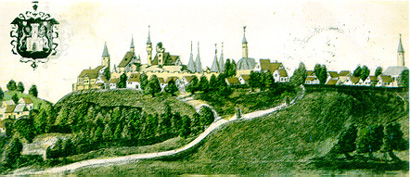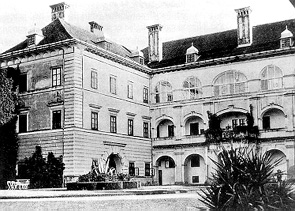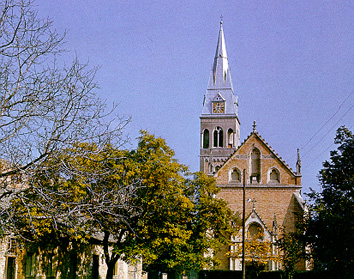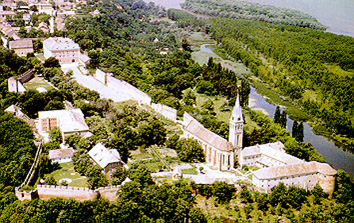|
VUKOVAR and ILOK
|
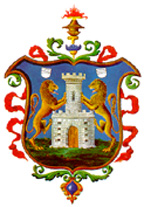 The tradional Coat of arms of the City of Ilok. |
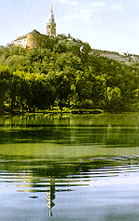 View up from Danube river's left bank westwards towards the fortress of Ilok. |
We had to leave Ilok soon although there would more to see say the museum and the last baroque mansion built for the family of Brnjakovics. King Leopold I. Habsburg bestowed the baron's title to Andrija Brnjakovic known as "Grubisic od Olova" (= Leaden Grubisic) in 1659 after he had fled from Bosnia because of Turks' intrusion. The Brnjakovic's clan got large properties in Slavonia after it was liberated and kept the Court Rights until 1803 when the last of Brnjakovic's died. After that their possessions were taken over by the Odescalchi's clan including the Court Rights in the town of Ilok.
The time was running out for us in Ilok when Bruno suggested to drive us to Aljmas on the Danube before we would return to Osijek. The return drive was more pleasant passing the lovely country sites through villages of Sarengrad and Sotin but soon we were back to the realities of war after as we drove straight trough the torn City of Vukovar. We moved onward up to Borovo where Bruno turned right on the road leading towards Dalj almost directly across the so dubbed "Serbian enclave". The enclave includes the settlements of Borovo proper, Borovo Selo (= village) and Borovo Naselje (= commune). One hardly notices any damages as the result of the recent warlike turmoil but one still feels there some air of uneasiness when travelling through these neighborhoods. We haven't seen too many people moving around or sitting in front of their dwellings, as it's the custom here during late afternoon hours. Houses were not decorated with the Croatian flag here what we have noticed before driving through the villages where Croatian population dominates.
* * * * * *
Notes about the "Serbian enclave"
There are some important historic facts referring to the population origin in the "Serbian enclave". The development and implications there had not played any important role in the population's ethnic or national composition in the Croatian Danube basin. The Serbian (Orthodox) settlements in areas around the towns Vukovar and Osijek are linked to the Turkish invasion of Syrmia and Slavonia regions early of the 16th century. Various armed groups trailed behind the Turkish army coming from the Balkan's interior some of the populace were Serbian origin but foremost of them were Vlachs or Vallachians. Vlachs were acting as the auxiliary troops in the Turkish army. For certain reasons the Vlachs were considered to be of Serbian origin after they have settled along the strategically extremely important main road Vukovar - Osijek around 1537.
The new Hungarian-Croatian authority, actually of the Habsburg Monarchy, introduced a new civil order to the liberated areas following the 1699 Karlovci peace treaty. Peoples in the "Serbian enclave" have had the chance to accept the cultural transformation and development as their own social, economic and spiritual stance at that time. Their neighbor Croats, Hunga-rians and recently settled German population had accepted the values and the disposition for the civilization of Central Europe already. However the Serbs in Vukovar region had rejected this transformation owing to their assumed military status that would have require to free the V1ach's population from any authority or influence of Serb Orthodox Church at first. The later one turned out to be the originator and propagator of the ideology of a Serb Balkan Hegemony. The Serbs were for their exclusiveness resulting in an aggressive expansionism in areas of Central Europe's in the eastern Danube valley. Also the Habsburg's authorities donated the Dalj manor as a deed of gift to the Serb Metropolitan bishop in 1706.
The newly metropolitan estate included the settlement of Dalj and the two other strategically important areas around Bijelo Brdo on the Danube and Borovo settlement dominating the Vuka River area too. The guidelines were issued from the center at Borovo village to be valid for the whole Vukovar "Serbian enclave" although the "enclave" for itself was a feudal estate of Town of Vukovar. In a triangle like area amid Osijek - Dalj - Borovo the Serb population persistently refused to accept the evolutionary progress of civilization in culture and society. The aspiration for the "Great Serbia" spread into the Croatian regions of Baranja, Slavonia and Srijem under the constant guidance of a reputably conservative Serb Orthodox Church. For this purpose was the so detached "Serbian enclave" conveniently located in this strategically most important area of the Drava-Vuka-Danube river basin.
* * * * * *
The whole region North of Vukovar was subjected to severe convulsions of population's composition that started after the end of Word War I. in 1918. The first large migration occurred during the Kingdom of Yugoslavia (1918-1941) government's stipulated colonization of peoples from Bosnia, Serbia and Vojvodina. The next even more significant seizure was set off by the mass exodus of the German speaking population towards the end of World War II. In the following years from 1945 to 1991 too many empty homesteads were colonized mostly by Serb population and by significant industrial developments in this region too. The last probably the most tragic one resulted from the expulsion and annihilation of all non-Serb population that didn't moved out from occupied territories by the unwanted aggressor. It will take time to heal these deep wounds of the inhabitants and the most appalling remembrances of the returnees.
Dalj village was a rather rich and contented one that I remembered from my last visits there in 1942/3 but now it was a rather grief-stricken. It happened here the first bloodshed in which some 200 people were massacred in April 1991. Coming to the main road of Osijek we turned right and ascended the Erdutsko brdo (= mount) before descending to Aljmas that is situated slightly above the Danube's bank. Aljmas was a small village that inhabitants had to abandon it saving their lives by embarking on tugboats that drove them upriver Danube and Drava to Osijek. They were living in Osijek as refugees for almost 7 years and are waiting anxiously to get back into their homes and to bring the Holy Lady's sculpture back to their completely demolished church now.
Since 1704 Aljmas became the place of peregrination to the Holy Mother of Asylum. Croatians have venerated the Holy Mother since ancient history times in their present homelands. The way was open to Eastern Slavonia and Syrmia after the Turks defeat at Harsany and the liberation of Osijek by 1687. However the pilgrimage to Aljmas started first at a place Lug (or Lasva) some 1,5km from Bilje north of Osijek in Baranja. There the Calvinists got hold of an old solidly church built by the Catholics so a Jesuit Padre Djuro Grcic had to build a small chapel at Lug instead. It was constructed of branches and plastered with mud and had an open bell tower on tall timbers next to it. The bell rang calling people to the service and in case of danger before enemy or brigands or outlaws plundering these tormented areas. Padre Grcic ordered a wooden statue of the Holy Mother that was brought to Lug to be consecrated there on the Day of Assumption August 15, 1687.
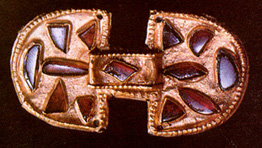
Golden links decorated with almadin stones possibly from Hunish sheath
found at Zmajevac, Baranja. (Archeological Museum of Zgareb)
The regional Croatian population
suffered a lot during the Hungarian rebellion under Rakoczy Ferenz
II against the Habsburg's dynasty of 1704 that had destroyed many
sacral edifices too. People were coming by boats or on foot to Lug
as pilgrims for some time until rebellious Rakoczy's Calvinists threatened
to destroy all Catholic sacral places. It was decided then to place
Holy Mary's statuette in a boat and let it float down the river Drava
in summer of 1704. The boat with it treasure was found in the reeds
near Drava's confluence in Danube at Aljmas soon after. Jesuits decided
then to build a new church at Aljmas then. Padre Marko Jurin consecrated
this place of the Holy Mother of Asylum on November 20, 1704 that
is the Day of Announcement to Blessed Holy Virgin.
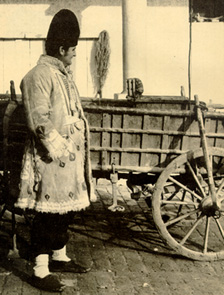 Man in a fur coat and cap from Ilaca |
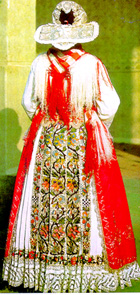 Woman's festive costume from Lovas |
After 1706 a new day had been arranged for pilgrimage to Aljmas on 2nd July the Day of Holy Mother Ascent that was kept until 1991 when the rebellious Serbs destroyed the church. In 1710 one completed the sacral edifice construction and placed there in the treasured sculpture on September 8, 1715. Later a newer Holy Mother's sculpture was found almost intact in the ruins of completely destroyed church in Aljmas and brought to save keeping in Osijek on 31.10.1992 and where it is still now. The church in Aljmas went through many turbulent times like in 1739 during that of the Great plague but the loses of population where by far lower than in other parts of Slavonia and Syrmia. According to reliable record few horrible animal infections didn't cause any harm to the Aljmas livestock similar as during the great locust plague in 1784. The people believed that the miraculous Holy Mother of Asylum looks over and protects them of the evils. Unfortunately the church got on fire in 1846 that destroyed the statue of 1704 of which the picture remained intact hanging over the main entrance.
Soon started the construction of new edifices that were backed up by public and a nobleman Antun Adamovic from Aljmas too. A new sculpture similar to the old one was ready and placed on the new altar 1847. The attached, now former, bell tower of an unusual form was completed in 1848 after Banus Josip Jelacic crushed the Hungarian rebellion saving the Monarchy and Habsburg's crown. Any pilgrim coming to Aljmas went also to visit another place as the chapel of "Mother of Linden tree" (also known as "Vodice") some 10 minutes walk from the parish church. The chapel place is in a small valley between two hills and above a fresh water spring. At first one placed there the saved picture from burned down old church and later the old sculpture was placed here instead. Msgr. Strossmayer Bishop of Djakovo had donated a new sculpture made Vienna in 1865 that was recovered under the ruins in 1992. The strange looking bell tower was reconstructed around 1898 but the Serb paramilitary aggressor destroyed it completely together with the church and parish's abode after August 15, 1991. The assailants demolished all sacral edifices and flattened the grounds during next two years allowing only the removal of slightly damaged sculpture to Holy Mother of Asylum.
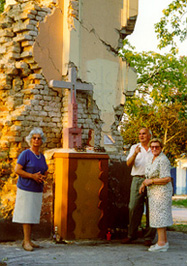
Shadows of the setting sun turn the only remaining corner aglow.
Friends from Osijek and Ljiljana stand next to a podest for
showing the model of the former church (bell) tower.
I do remember well the places of pilgrimage in Aljmas that I've visited on several occasions. Some times I went there with schoolmates on day trip spending most hours in games in thickets and reeds nearby. Few times I was with father who rowed down river from Osijek to Aljmas where guests and pilgrims spent many hours eating, drinking and singing. At late afternoon everybody was too tired to raw against the river flow so ready waiting tugboats pull the boaters back home to Osijek or other places they came from. However the visit to Aljmas was always a happy and joyous affair for me so far I could remember. And now, the place looked absolutely strange and unfamiliar to me as it looks so gloomy and depressing. It's so quite around as one hardly could see anybody walking by. We went to view what was left of parish church: a bell tower's corner wall and pieces of roof beams braced against. A very sad and disheartening sight.
After a short drink in one of the two small pubs in Aljmas Bruno had urged to get back as it was late afternoon. We were coming down from the Erdutsko brdo when the reddish sun was setting in already. Back on the main road to Osijek our good driver had to pay all his attention to stay on tarmac because at both sides were mined fields overgrown with weeds and high grass. My spirit was at rather low level as my childhood's recollection had to give way to the grueling reality. One recollection after the other one was bursting like a balloon at pin's touch. The crimson sun went down fast and the black tower silhouette of Osijek parish church appeared in sun's last rays. The sky was lit red, bright red like as the blood spilled all over this region for too often now. I wonder whether there would come times to be ruled by good relations, peace and harmony ever?
To conclude my reminiscences I cite Jacob Count Eltz of Vukovar, who wrote in Zagreb for Christmas 1993 about singing in a past Kolo dance: "What was been shall be again and we'll live to see it". I've wondered whether Seneca stated in his Epistolae Lucilium 94,28 appropriately: "Iniuriarium remedium oblivio" meaning that: "The oblivion is the best healing of all evils".
* * * * * *
Note 1: Please read more about the sojourn at web page titled VUKOVAR and ILOK (Part 1/2) and subtitled VUKOVAR - WOLKOVAR - VUKOVO - CASTRUM WOLCO.
Note 2: See also web page REGIONAL HISTORY of VUKOVAR and ILOK.
* * * * * *
Main sources of data and pictures:
1. VUKOVAR - ETERNAL CROATIAN TOWN ON THE DANUBE by Editor in Chief: Igor Karaman; Editorial Board: Dragutin Feletar, Vlado Horvat, Josip Jurcevic, Zlatko Karac, Nives Majnaric-Pandzic, Ruzia Maric, Filip Potrebica & Zeljko Tomicic. Publisher: NAKLADNA KUCA "DR. FELETAR" Koprivnica - Croatia, Trg mladosti 8. ISBN: 953-6235-00-5.
2. DVORCI I PERIVOJI U SLAVONIJI (Castles and parks in Slavonia) by Mladen Obad Scitaroci and Bojana Bojanic Obad Scitaroci. Publisher: MLADEN OBAD SCITAROCI, Zagreb 1998.
3. BORDERS OF CROATIA ON MAPS from 12th to 20th century published by The Museum of Arts and Crafts Zagreb.
4. ESSAYS by Prof. Stjepan Srsan published in the newspaper "GLAS SLAVONIJE" in Osijek from 1998 onwards.
* * * * * *
DISCLAIMER : On URL: http://www.cosy.sbg.ac.at/~zzspri/ published pages are originals and authorized by copyright of Zvonko Z. Springer, Salzburg 1999.
Email Zvonko Springer at : zzspri@aon.at
Croatia - its History, Culture and Science
